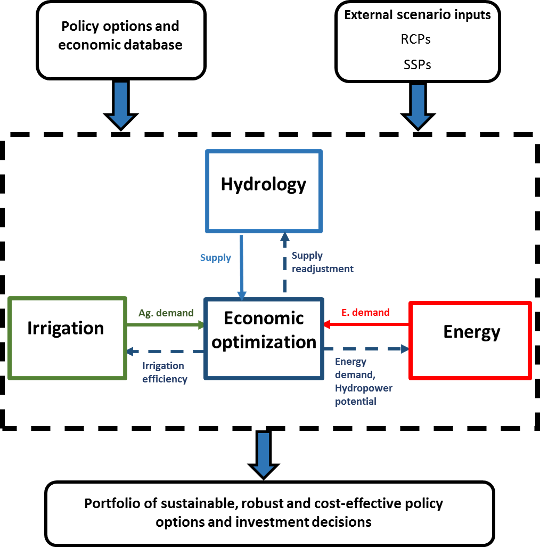
New tool to inform the design of cost-effective and sustainable water policy decisions
Summary
The Global Hydro-economic Model (ECHO) is a bottom-up system analysis framework which can be used to develop integrated, long-term planning strategies for the water system.
It can be used to inform the design of cost-effective and sustainable water policy decisions and to address the impacts of future changing socio-economic and climatic conditions on water system. The Global Hydro-economic Model is a new element of IIASA’s water program which provides a technology rich basis for estimating water system dynamics over a long-term, multiple period time horizon. The model operates at global, regional and basin scales.
Drivers
The pressure on water resources has been mounting worldwide, with water scarcity becoming a widespread problem in most arid and semiarid regions around the world. Global water extractions have increased more than six fold in the last century, which is more than twice the rate of human population growth. However, the impact of growing water scarcity on long-term sustainable development has not been adequately addressed by the integrated assessment research community. Specifically, the allocation of water resources across regions and sectors at the global level remains largely unaccounted for in long-term modeling. To reconcile potential inconsistencies introduced by constraints on future water availability, IIASA researchers are developing the Global Hydro-economic Model.
FAST FACTS
- Can be used to understand the impacts of future socio-economic and climatic conditions on the water system and explore policy options
- Can be used to addressing future water challenges at a range of scales
- Is a novel bottom-up technology-rich system analysis framework which integrates biophysical, economic and institutional components
- Will be linked to existing IIASA model
Model design and processes
The model uses optimization to balance global water demand and supply at the level of large-scale river basins. The technique allows the model to minimize the total costs (more accurately loss of total economic surplus) of meeting the water demands from the agricultural, industrial (energy and manufacturing), and domestic sectors, while also taking into account various resource, institutional, and environmental constraints, such as retaining enough water for healthy aquatic ecosystems.
 © IIASA
© IIASA
Global Hydro-economic modeling framework
The model can be used to simulate a variety of basin management decisions including resource extractions, interbasin transfers, reservoir storage, and water infrastructure investment (i.e., the choice of the size and location of new water projects). The model provides information on the trade-offs and synergies among these various policy options. One important advantage of the Global Hydro-economic model is the ability to model policy options at multiple spatial scales. This is increasingly necessary given that local conditions constrain water supply system, while some policy interventions such as international trade and transboundary agreements can only be assessed at global scale. Moreover, solutions identified at the global scale need to be validated in the regional context given that management, policy, and investment decisions are made at national and sub-national levels.
The model uses information on water demand and availability provided by existing global integrated assessment models at IIASA, including the Community Water Model (CWATM); the Model for Energy Supply Strategy Alternatives and their General Environmental Impacts (MESSAGE); and the Global Biosphere Management Model (GLOBIOM), and provides information on water resources development, allocation and cost to those models.
 © IIASA
© IIASA
Example output
 © IIASA
© IIASA
Example output
References:
[1] Wada Y, Flörke M, Hanasaki N, Eisner S, Fischer G, Tramberend S, Satoh Y, van Vliet M, et al. (2016). Modeling global water use for the 21st century: Water Futures and Solutions (WFaS) initiative and its approaches. Geoscientific Model Development 9: 175-222.
[2] Kahil MT, Ward F A, Albiac J, Eggleston J, & Sanz D (2016). Hydro-economic modeling with aquifer-river interactions to guide sustainable basin management. Journal of Hydrology 539: 510-524.
[3] Kahil TM, Ward FA, Albiac J, Eggleston J, & Sanz D (2016). Hydro-economic modeling of conjunctive ground and surface water use to guide sustainable basin management. In: European Geosciences Union (EGU) General Assembly 2016, 17–22 April 2016, Vienna, Austria.

